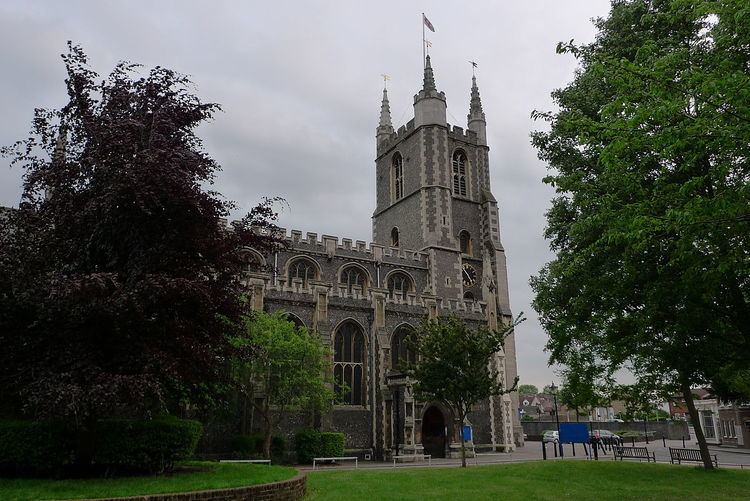Country United Kingdom | Style English Gothic Phone +44 20 8688 8104 | |
 | ||
Deanery Croydon Central deanery Address Church St, Croydon CR0 1RN, UK Similar Museum of Croydon, Shirley Windmill, Wandle Park tram stop, Croydon Palace, Croydon Clocktower Profiles | ||
Croydon Minster is the parish and civic church of the London Borough of Croydon. There are currently more than 35 churches in the borough, with Croydon Minster being the most prominent. It is Grade I listed.
Contents
- Croydon town centre and croydon minster
- Medieval church
- Destruction rebuilding and modern history
- Organ
- Organists and Masters of Choristers
- Bells
- References
Six Archbishops of Canterbury are buried in the church: Edmund Grindal (d.1583), John Whitgift (d.1604), Gilbert Sheldon (d.1677), William Wake (d.1737), John Potter (d.1747), and Thomas Herring (d.1757).
Croydon town centre and croydon minster
Medieval church
The church was established in the middle Saxon period, and is believed to have been a minster church: one which served as a base for a group of clergy living a communal life, who may have taken some pastoral responsibility for the population of the surrounding district. A charter issued by King Coenwulf of Mercia refers to a council which had taken place close to what is called the monasterium (meaning minster) of Croydon. An Anglo-Saxon will made in about 960 is witnessed by Elfsies, priest of Croydon; and the church is also mentioned in Domesday Book (1086).
The earliest clear record of the church's dedication to St John the Baptist is found in the will of John de Croydon, fishmonger, dated 6 December 1347, which includes a bequest to "the church of S. John de Croydon".
In its final medieval form, the church was mainly a Perpendicular-style structure of late 14th and early 15th-century date. It still bears the arms of archbishops Courtenay and Chicheley, believed to have been its benefactors.
Destruction, rebuilding and modern history
The medieval building underwent some restoration in 1851 and 1857–9, under the direction of George Gilbert Scott. However, on the night of 5 January 1867, a fire broke out – possibly caused by overheating from the poor positioning of the flues of recently installed Gurney stoves – which eventually gutted the entire building. It was rebuilt to Scott's designs between 1867 and 1869, incorporating some of the medieval remains (notably the west tower and south porch), and essentially following the medieval plan, while enlarging the building by extending its footprint further east. The church's reconsecration by Archbishop Archibald Tait took place on 5 January 1870. The church still contains several important monuments and fittings saved from the old building.
The church was elevated to the status of Croydon Minster (the modern honorific title) on 29 May 2011, the first such change in the diocese of Southwark.
Croydon has strong religious links, Croydon Palace having been a residence of the Archbishop of Canterbury from at least the beginning of the 13th century to the beginning of the 19th. The Bishop of Croydon is a position as an area bishop in the Anglican Diocese of Southwark. The current area bishop is Jonathan Clark, who was consecrated on 21 March 2012. Until recently (mid 2016) the vicar was Colin J. Luke Boswell, Vicar of Croydon and Chaplain to the Whitgift Foundation.
Organ
The church has a large four-manual pipe organ, much of which is by William Hill & Sons and dates from 1869. A specification of the organ is on the National Pipe Organ Register.
There is also a small organ in the St Nicholas Chapel which was obtained from St Mary the Virgin, Preston Candover in 1997. A specification of the chapel organ is on the National Pipe Organ Register.
Organists and Masters of Choristers
Before the fire of 1867 records are incomplete, but include:
After the fire of 1867:
Organists Laureate
Organists Emeritus
Bells
The tower houses a ring of 12 bells cast by the Croydon firm of Gillett & Johnston in 1936, replacing an earlier ring of eight. The eight original bells were recast and hung with new fittings in a new frame with four additional trebles. The new ring of 12 was dedicated by the Bishop of Croydon on 12 December 1936 and the first peal on the new 12 was rung for the coronation of King George VI and Queen Elizabeth in 1937.
The tower and ringers are affiliated to the Surrey Association of Church Bell Ringers.
